Dominican Republic
From the New World firsts of Santo Domingo To The Plush Resorts Of Punta Cana. A pictorial Look At A True Hispanic Caribbean Gem
A palm tree on Bavaro Beach, Punta Cana, Dominican Republic. May 28, 2015
Dominican Republic
From escaping Haiti to the New World firsts of Santo Domingo to gate-crashing the plush resorts of Punta Cana. I enjoyed it all so much that I stayed one day longer than I should have. A pictorial look at my time in Dominican Republic, a country with a dominant Hispanic culture, world-class resorts on fine beaches, lots of colonial-era history and untrammelled inland areas with forbidding peaks.
Read all postings from the Dominican Republic road in chronological order or jump to specific postings using these links.
SANTO DOMINGO, THE CAPITAL ‘LA CAPITAL’ – Arrival, Hispaniola & Historic Santo Domingo || The Haircut (& Facial) || SD – An Exploration
PUNTA CANA – The Beaches & All-Inclusive Resorts || The Missed Flight & Late Departure
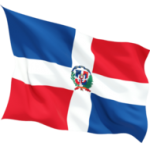
Dominican Republic (May 24 – 29 2015)
Posts From The Dominican Republic Road (In Chronological Order)
ARRIVAL, HISPANIOLA & SANTO DOMINGO
Date || May 24, 2015
Location || Santo Domingo ( )
)
Hispaniola
The island of Hispaniola, the most populous island in the Americas, is the second largest island in the Caribbean (after Cuba). It’s shared by two very different, to put it mildly, countries, two former European colonies & countries that today don’t particularly like each other – French (& Creole) speaking Haiti & Spanish speaking Dominican Republic (DR), the latter of which is far bigger than the former occupying as it does the eastern two-thirds of the island’s 76,000 km² (their dislike of each other stems from Haiti’s 23-year occupation of Dominican Republic, between 1821 and 1844). Today a north-south border separates the two countries, a border I crossed today in getting from the Haitian capital of Port-Au-Prince to my present location of Santo Domingo, the DR’s capital and the largest city in the Caribbean. Seven hours the 320 kilometre journey took, most of it spent in the DR – from Port-Au-Prince to the border is only some 60 kilometres but once over the border you may as well be on a different continent such is the difference between the two countries. Don’t get me wrong, the DR isn’t exactly a wealthy country. But it’s all relative & when compared to Haiti the DR looks and feels like Monaco. OK, so I’ve only been here a few hours yet. That said, & when all is said & done, I doubt I’m going to sprout anything but positives about my time in the DR. After all, it has infrastructure (well-maintained roads & buildings), clean & ordered streets on which you’ll see modern cars, &, best of all, a sense of tranquility you’d be hard pressed to find over the border in Haiti. So far so good.
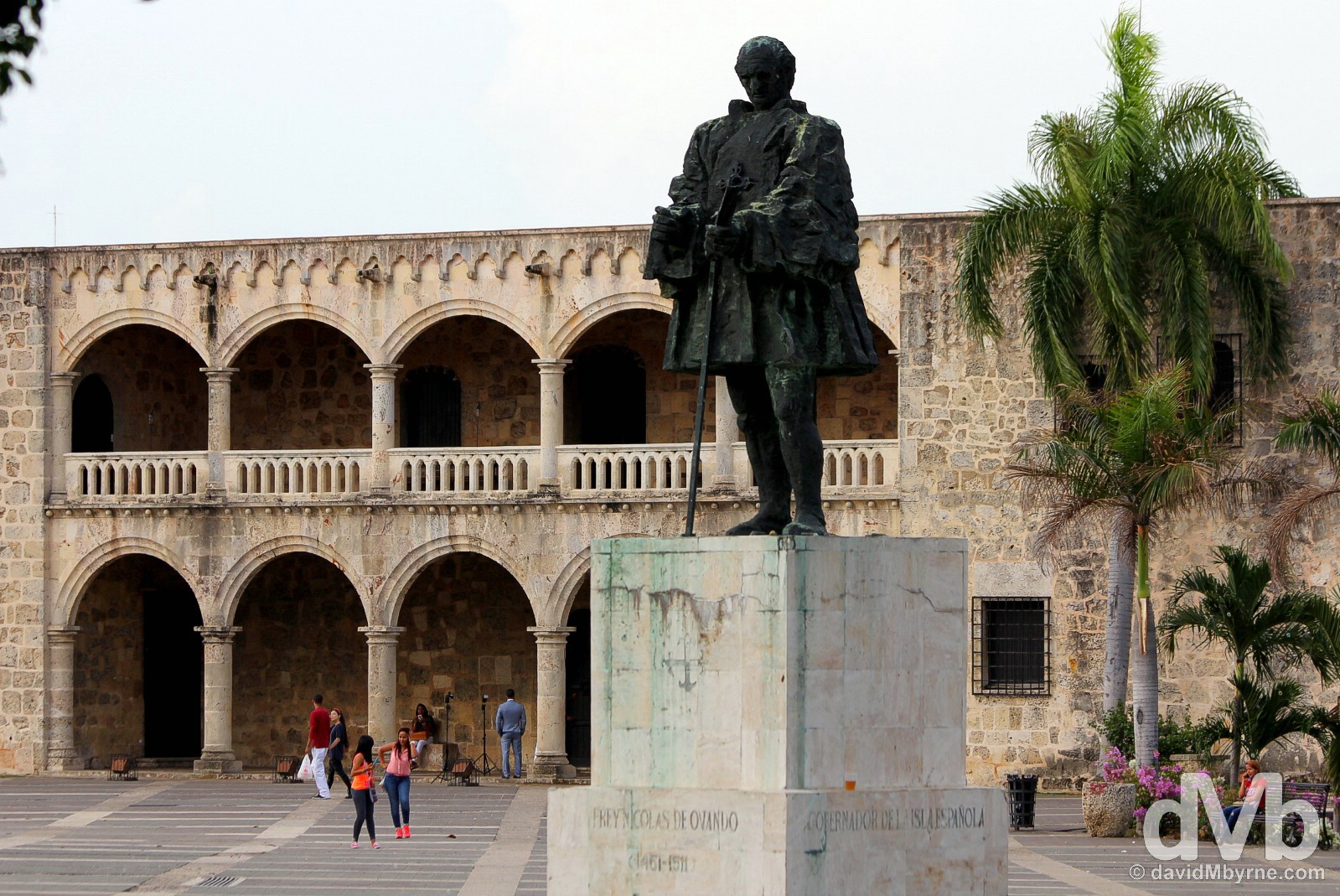
I’ll have a proper look around Santo Domingo over the coming days but this afternoon, & with the madness of Haiti still ringing in my ears & its dust still resting in my nostrils, I was happy to watch the peaceful Santo Domingo world go by from a cafe overlooking one of the Zona Colonial’s plazas, Plaza Espana, last renovated in the 1990s to mark the 500th anniversary of Columbus’ arrival in the New World. It’s said that the building seen here, Alcazar de Colon, the plaza’s defining feature and one of the most striking buildings in the city’s historic Zona Colonial, was once the home of Columbus’ son Diego. Designed in the Gothic-Mudejar transitional style, it has been renovated many times, most recently in 1992, and today houses a museum of household pieces said to have belonged to the Columbus family, just one of many museums to be found in the vicinity. Oh and the statue? That’s one Nicolas de Ovando, the early governor of the city who had it rebuilt in stone after the original wooden structures were destroyed by a hurricane in 1502. The inscription on the stone pedestal reads “Mayor Commander of the Order of Alcantara” and “Founder of the New City of Santo Domingo.” Plaza Espana, Santo Domingo, Dominican Republic. May 24, 2015.
Historic Santo Domingo
The Caribbean’s largest city with a population of over 3 million, Santo Domingo is the centre of all things DR – it’s the cultural, economic & educational heart of the country. Its main draw is the compact Zona Colonial, a UNESCO-listed district of cobblestone streets with shady plazas & historic buildings galore (fortifications, monasteries, churches etc.); typical restored remnants of a typical Spanish colonial settlement. Except this settlement is a little bit more historic, a tad older than most. Santo Domingo was founded by way back in 1498, 6 years after Christopher Columbus had set sail from Spain on the first of the 4 voyages he would complete in search of Asia – Santo Domingo was the third settlement founded by the Europeans on Hispaniola but the first of them to prosper, meaning it is the oldest continuously inhabited European settlement in the Americas. Columbus didn’t find Asia (not surprising given the fact that he went west, not east) but by making landfall on Hispaniola, which he did in 1492, he did manage instead to discover the so-called New World, what we now know as the hemisphere that includes North & South America. Santo Domingo is therefore the oldest European settlement in the Western Hemisphere, a.k.a. the Americas, and among the lanes of the city’s compact Zona Colonial you’ll find a few New World firsts – its first paved street, first hospital, first monastery, first nunnery, & first European colonial fortress. Oh and the city also boasts the oldest church in the Americas still in continuous use today. So yes, there’s quite a bit of history here in Santo Domingo.
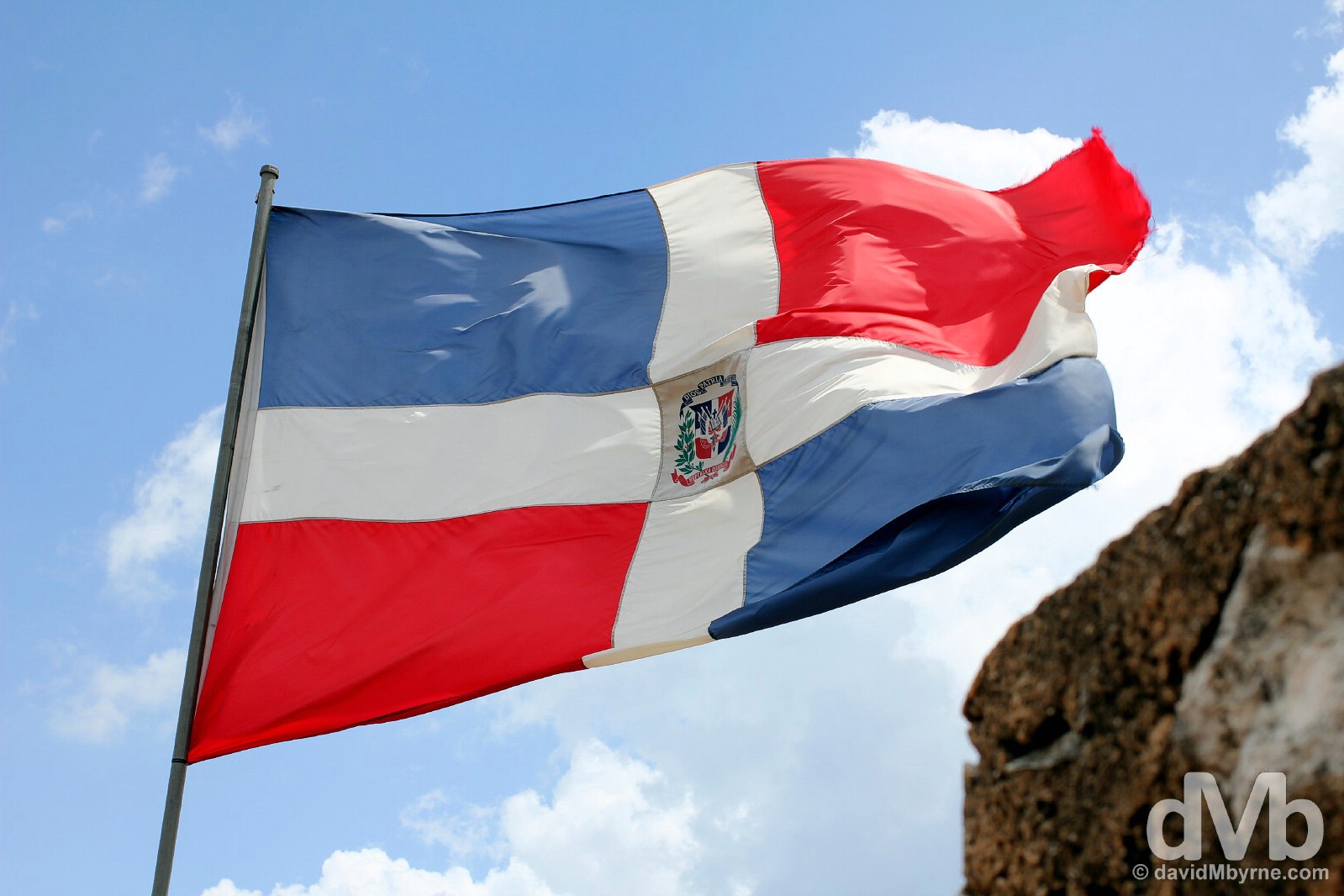
The Dominican Republic flag flying over the Torre del Homenage in Fortaleza Ozama, Santo Domingo, Dominican Republic, Hispaniola, Greater Antilles. May 26, 2015.
SANTO DOMINGO || THE HAIRCUT & FACIAL
Date || May 25, 2015
Location || Santo Domingo ( )
)
I don’t have much hair these days so getting it seen to doesn’t take long. Or at least it shouldn’t. An hour I spent in the ‘barbers’ today here in Santo Domingo getting a lot more than I bargained for. It started out as one might expect; I got comfortable in the chair, had a cape thrown around my shoulders, & he went to work with a 2 blade all over, a run-of-the-mill visit to the barbers. Again, it shouldn’t have taken too long, and wouldn’t have if not for all the shenanigans.
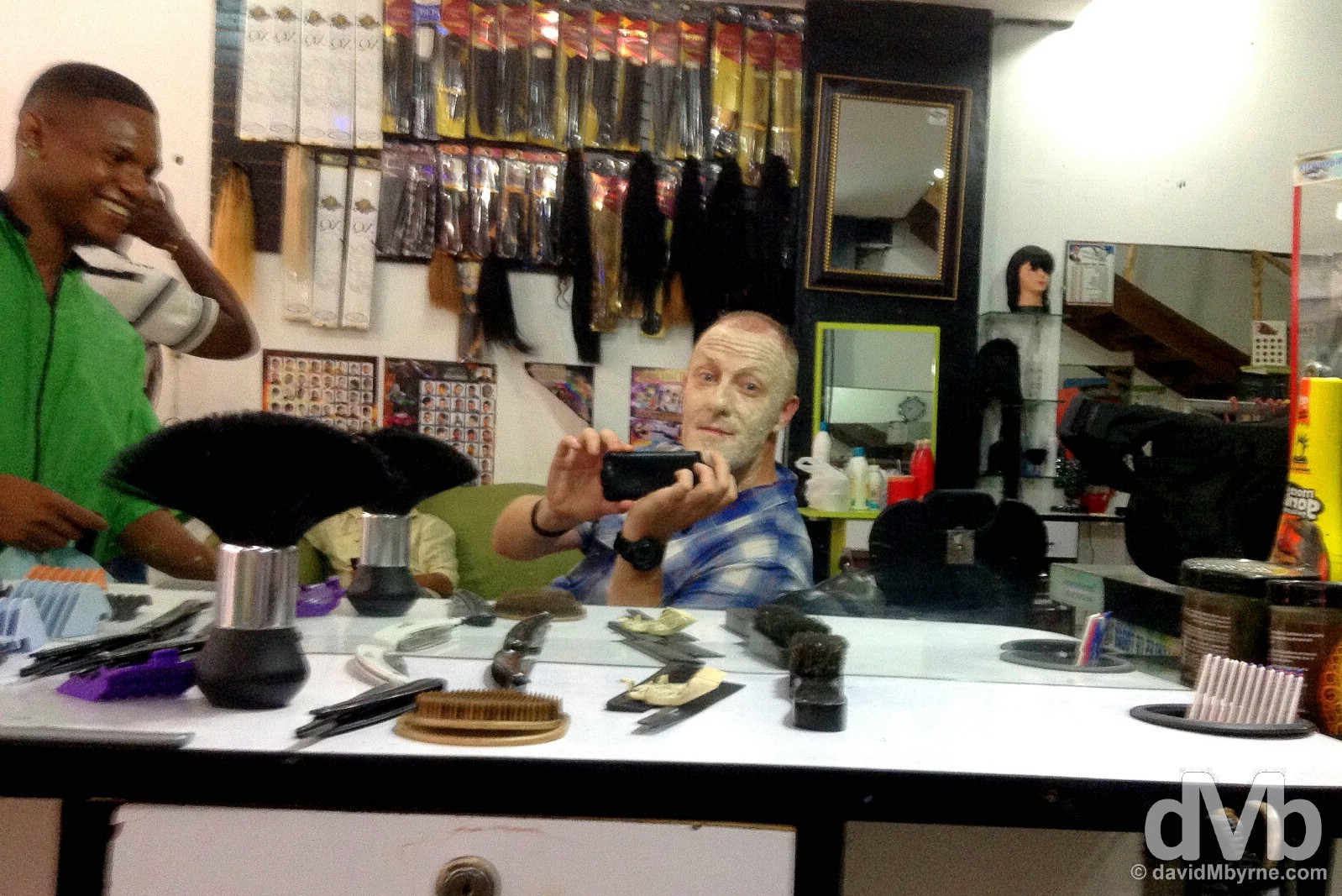
A 2-blade all over, please. Visiting the ‘barbers’ on El Conde, Santo Domingo, Dominican Republic. May 25, 2015.
First, I had to politely reject an advance from a, ahem, ‘Beauty Technician’ offering to give me a manicure & pedicure while I sat in the chair. ‘No gracias Señorita.’ (OK, & while the establishment had a barbers pole & stated the word ‘Barber’ above the door, it might not have been a barbers in the true sense of the word, maybe one that also offered sundry services, a one-stop unisex wellness/grooming shop if you like). Next up, & with the job nowhere near done, the power went (it happens a few times a day). So he downed the electric shaver, threw back the seat and with me staring at the ceiling proceeded to give me a dry, cutthroat shave working only via the ambient light seeping into the shop from outside. When that was done out came the gritty green, mint smelling, menthol soothing exfoliant. I went along with all this thinking maybe, just maybe, that’s how they do things here in the Dominican Republic. Or maybe he’s just killing time waiting for the power to come back on. Either way I lay there for a while, still staring at the ceiling, with a tingling face mask on the likes of which I’d never had before, or ever will again. He then disappeared only to return some minutes later with the aforementioned Beauty Technician who proceeded to led me into a candlelit back room, green face and all, before starting to unbutton my shirt as I stood by a massage table. Another ‘No gracias Señorita’ and that, with 2 rejections in the one day, was to be the last I’d see of her.
Back to the main saloon where the power mercifully returned while I was having my face liberated, getting a good scrubbing in the process (it was during this procedure that I took tha above picture). And when that was done it was decided to wash what hair hadn’t already fallen to the ground pre-power cut. Then, and only then, did I return to the chair for the shaver to finishing the only job I’d signed up for in the first place, but not before I was forced to remind him that I wanted a 2 all over, not just back & sides as he seemed only intent on doing. And that was that, the end of my trip to the Santo Domingo barbers. The biggest surprise of all? The bill, a rather arbitrary & wishful ‘we’ll-aim-high-and-hope-for-the-best’ 1,830 Pesos (€37), over 5 times the listed and agreed-upon-at-the-outset, haircut-only price of 350 Pesos (€7). Needless to say I protested and in doing so the price dropped immediately to a nice round 1,000 Pesos. More protests (my best Spanish is easily my price/purchasing related vocabulary). They quickly understood they were scamming the wrong gringo and I eventually hightailed it out of there 350 Pesos poorer but with a smile on my face & with one hell of a travel memory.
SANTO DOMINGO || AN EXPLORATION
Date || May 26, 2015
Location || Santo Domingo ( )
)
It rained a lot while I was in Santo Domingo. Three days I gave myself, adequate time to do the city justice while dodging tropical rain showers, a challenging mix when added to the ever-present heat & humidity. I did venture beyond the clearly defined boundaries of the city’s Zona Colonial, although not far beyond and not very often; there was/is, and as already stated, more than enough intriguing New World firsts in the city’s compact UNESCO-listed birthplace to appease most.
– UNESCO commenting on the Colonial City of Santo Domingo
New World First || Paved Street
The first of the city’s New World firsts that I grappled with was its rather mundane Calle de las Dames (Street of the Ladies). OK, so it’s a street, a run-of-the-mill, present-day asphalt road. But it’s one that is dotted with more than a few plaques of historical information affixed to the facades of the buildings lining it, some of which are nicely restored limestone structures that date back to the founding of the settlement in the late 13th to early 14th centuries.
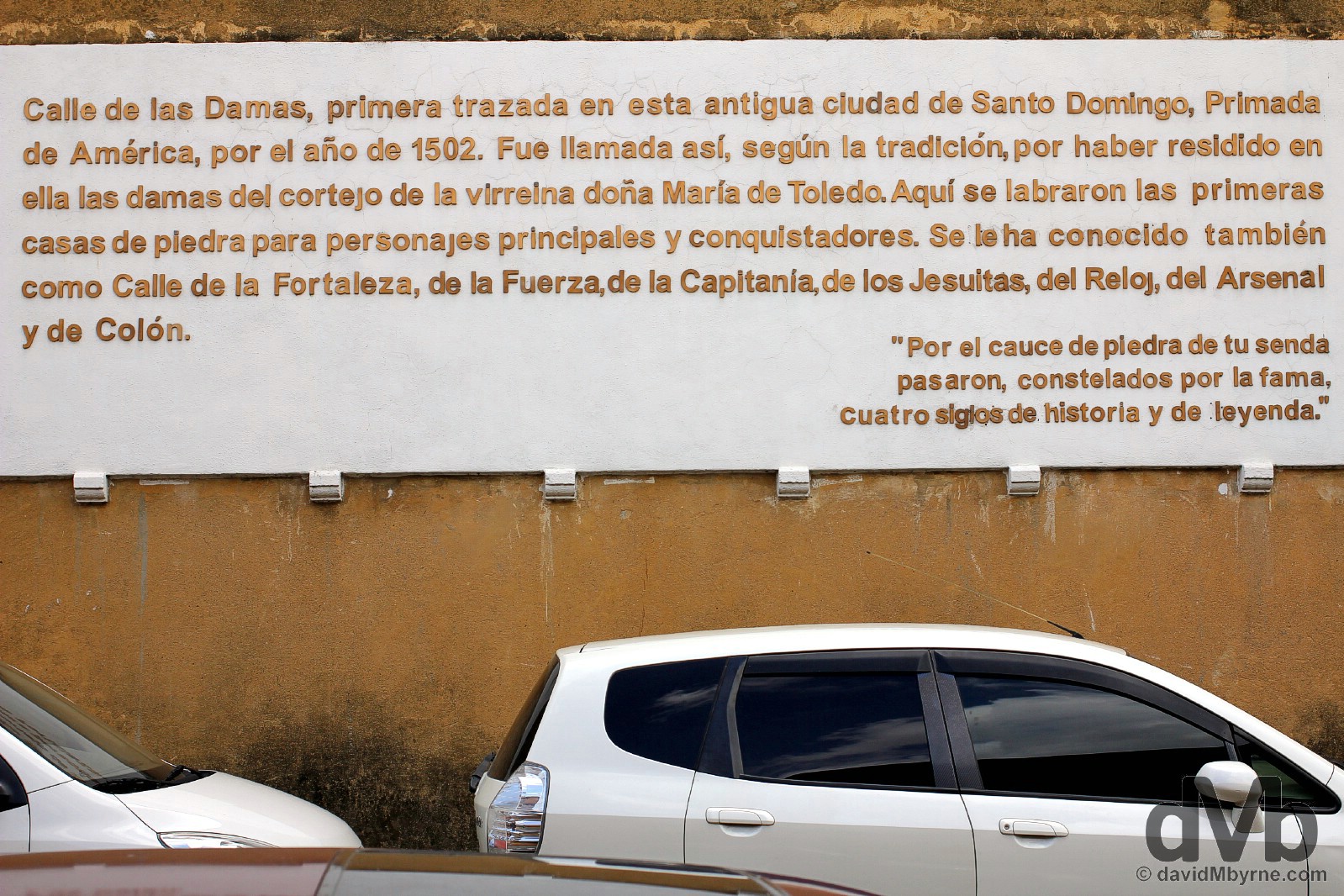
The biggest plaque of all on Calle de las Dames is this one, telling all who can decipher its text that the street was laid way back in 1502. That makes this road the first paved road in the Americas. So there. Calle de las Damas, Zona Colonial, Santo Domingo, Dominican Republic. May 26, 2015.
New World First || Colonial European Fortress
Also on Calle de las Dames is what remains of Santo Domingo’s Fortaleza (Fortress) Ozama, construction on which began in 1502 making it the oldest colonial military structure in the New World.
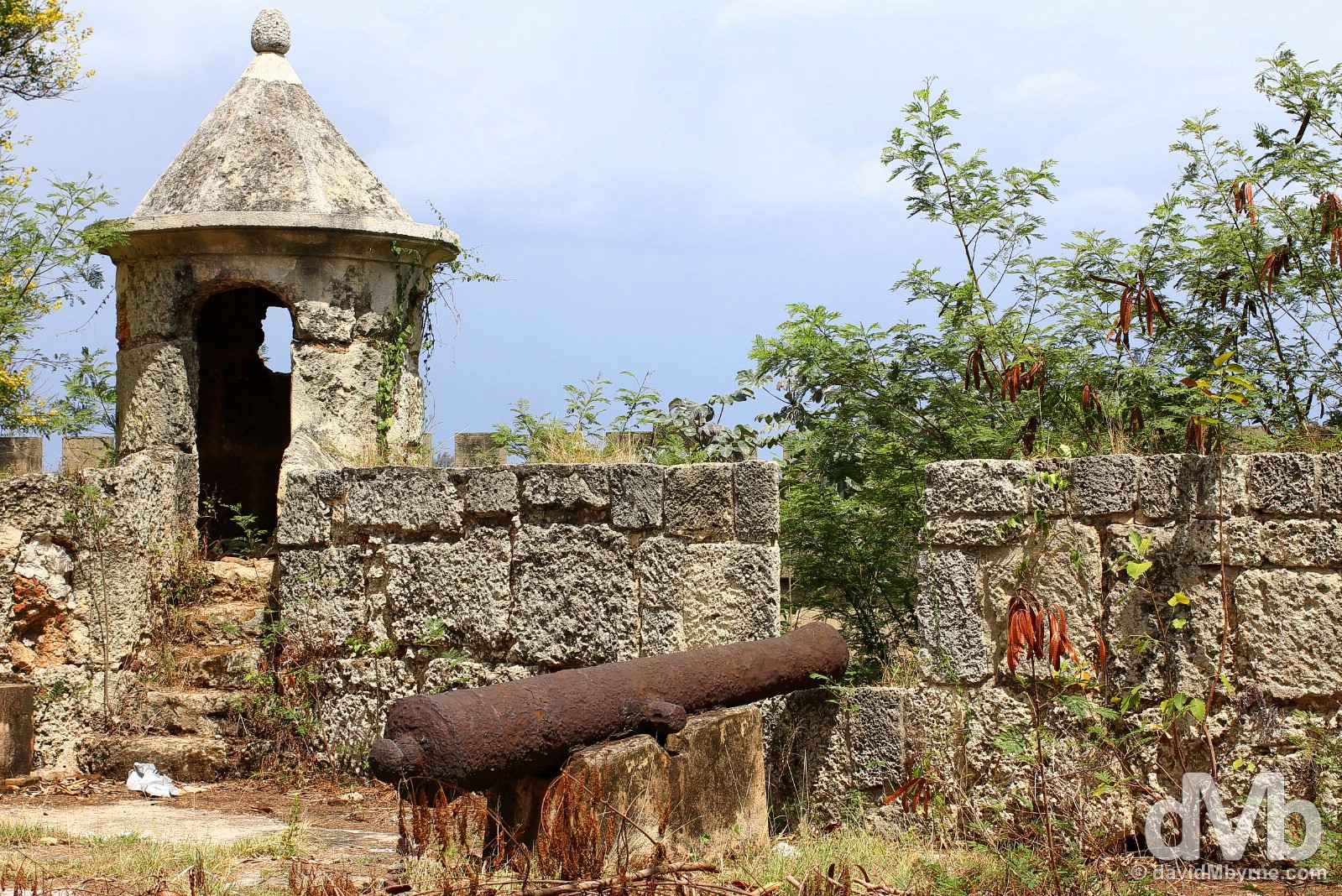
The fort was built to protect the new settlement & overlooks the confluence of the city’s Rio Ozama & the Caribbean Sea. While other parts of the fortress have seen some TLC over the years (see the next picture) this area of the fortress, with cannons dating from 1570 still in-situ atop the fort walls, has been largely ignored. Thus one gets a real sense of antiquity poking around here. Fortaleza Ozama (Ozama Fortress), Santo Domingo, Dominican Republic. May 26, 2015.
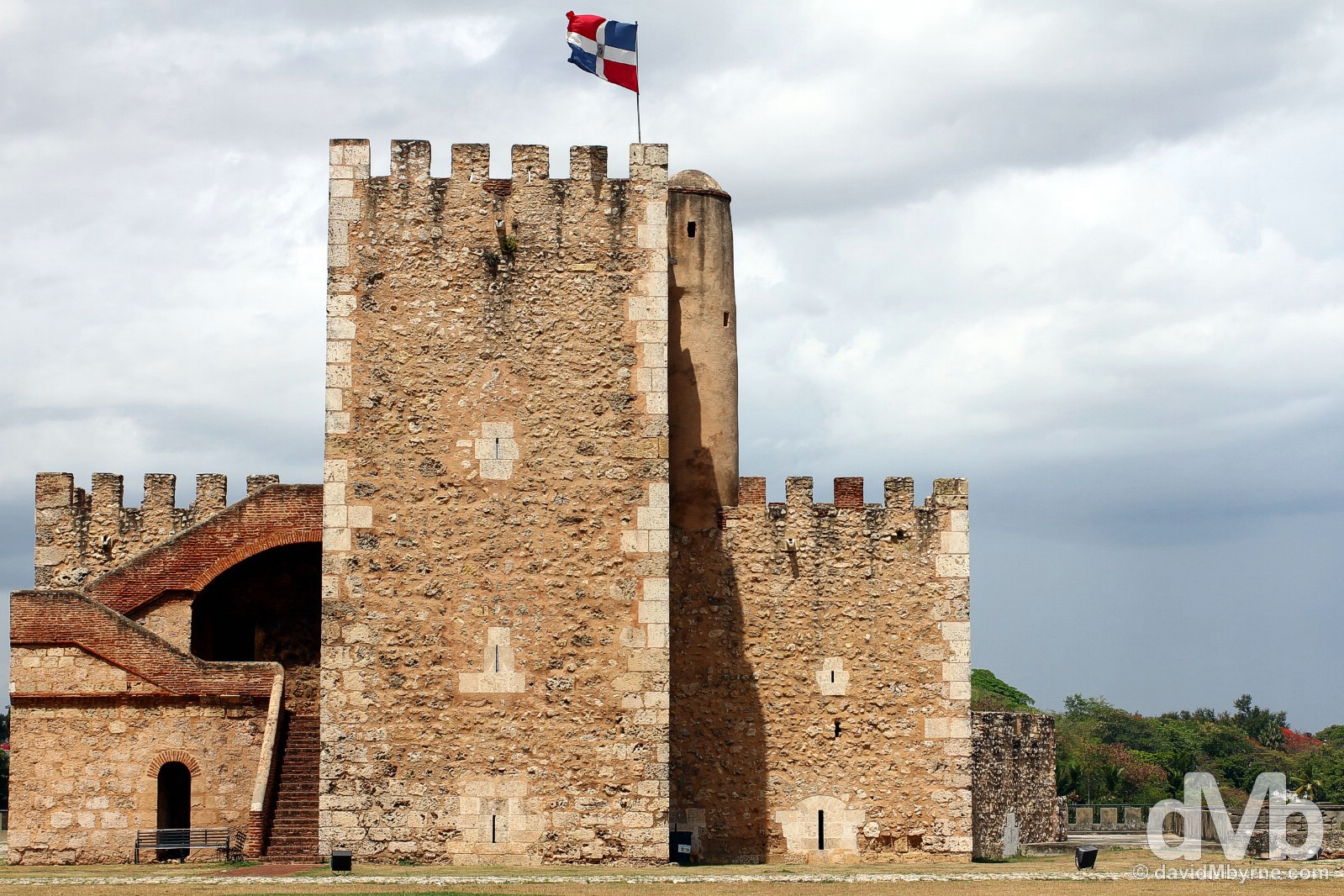
Fortaleza (Fortress) Ozama’s main structure is the hulking Torre del Homenaje (Tower of Homage). Today it flies the flag of the Dominican Republic (obviously) but over the years it has flown the emblem of Spain (independence from Spain was achieved first in 1821 & then for good in 1864), Haiti (which, & in a bid to unify the island of Hispaniola, occupied the DR from 1821 to 1844), the U.K., France, & the U.S. (here between 1916 & 1924). Torre del Homenaje (Tower of Homage) in Fortaleza Ozama (Ozama Fortress), Santo Domingo, Dominican Republic. May 26, 2015.
New World First || Hospital
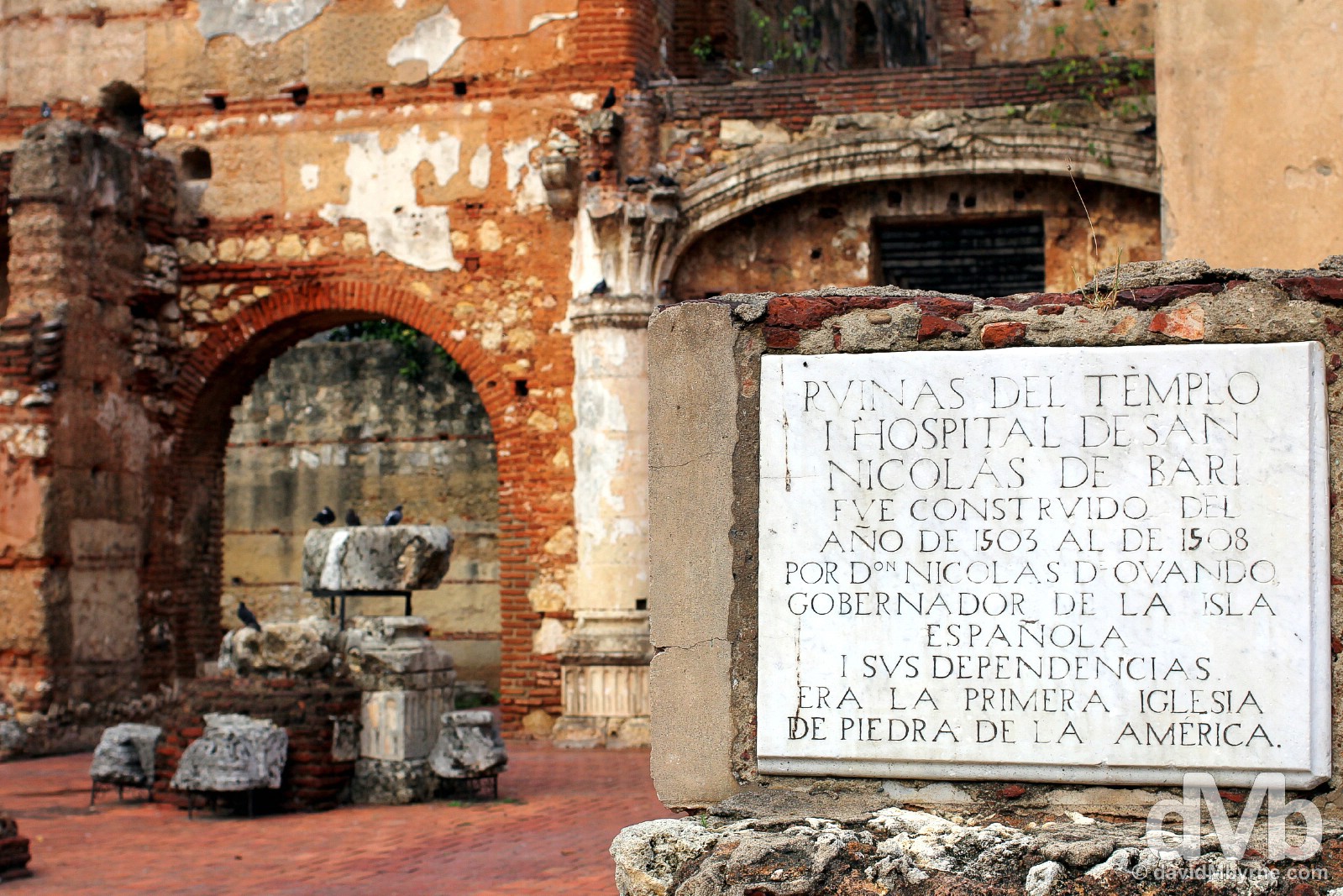
Another plaque, this one in the grounds of the ruins of San Nicholas de Bari, the New World’s first hospital. Construction began in 1503 and it was obviously built to a good standard – the structure, whose floor plan was in the shape of a Latin cross, survived attack by both man (mostly pirates) & nature (earthquakes, hurricanes etc.) and stood largely intact until 1911 when it came up against one hurricane too many. It was then purposely knocked down so as not to pose a hazard to the public. With all that resistance over the years it’s a shame that now the site lays in ruin and has been given over to yet more pigeons – they are everywhere in Santo Domingo and anyone who knows me knows I hate pigeons. Ruinas del Hospital San Nicolas de Bari, Zona Colonial, Santo Domingo, Dominican Republic. May 26, 2015.
Catedral Primada de America
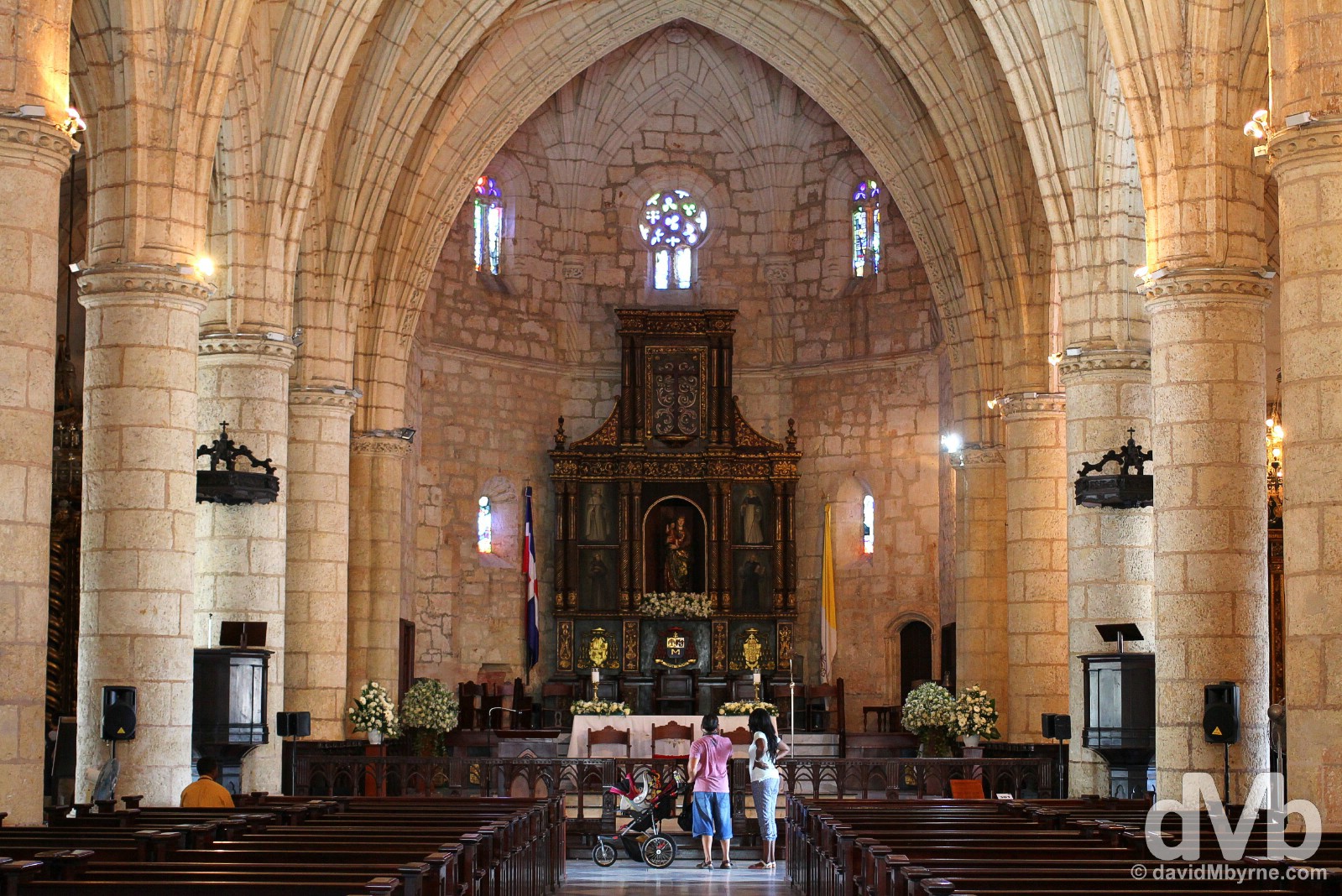
The first stone was set for Santo Domingo’s Catedral Primada de America (Primate Cathedral of America) way back in 1514 but work on its construction didn’t begin in earnest until 1521. It was completed in 1540. Boasting a mix of various architectural styles and missing a bell tower that was never finished, it’s the oldest church in continuous use in the Americas. Externally it’s a rather unassuming place, given its historic clout, but I loved its large, exposed limestone brick finish & the arched interior, one with no fewer than 14 chapels, 7 running either side of the central aisle seen here. Catedral Primada de America in Zona Colonial, Santo Domingo. Dominican Republic. May 26, 2015.
Parque Colon
Shady Parque Colon, on the north side of the cathedral & marking the start of El Conde (next picture), is the Zona Colonial’s main square.
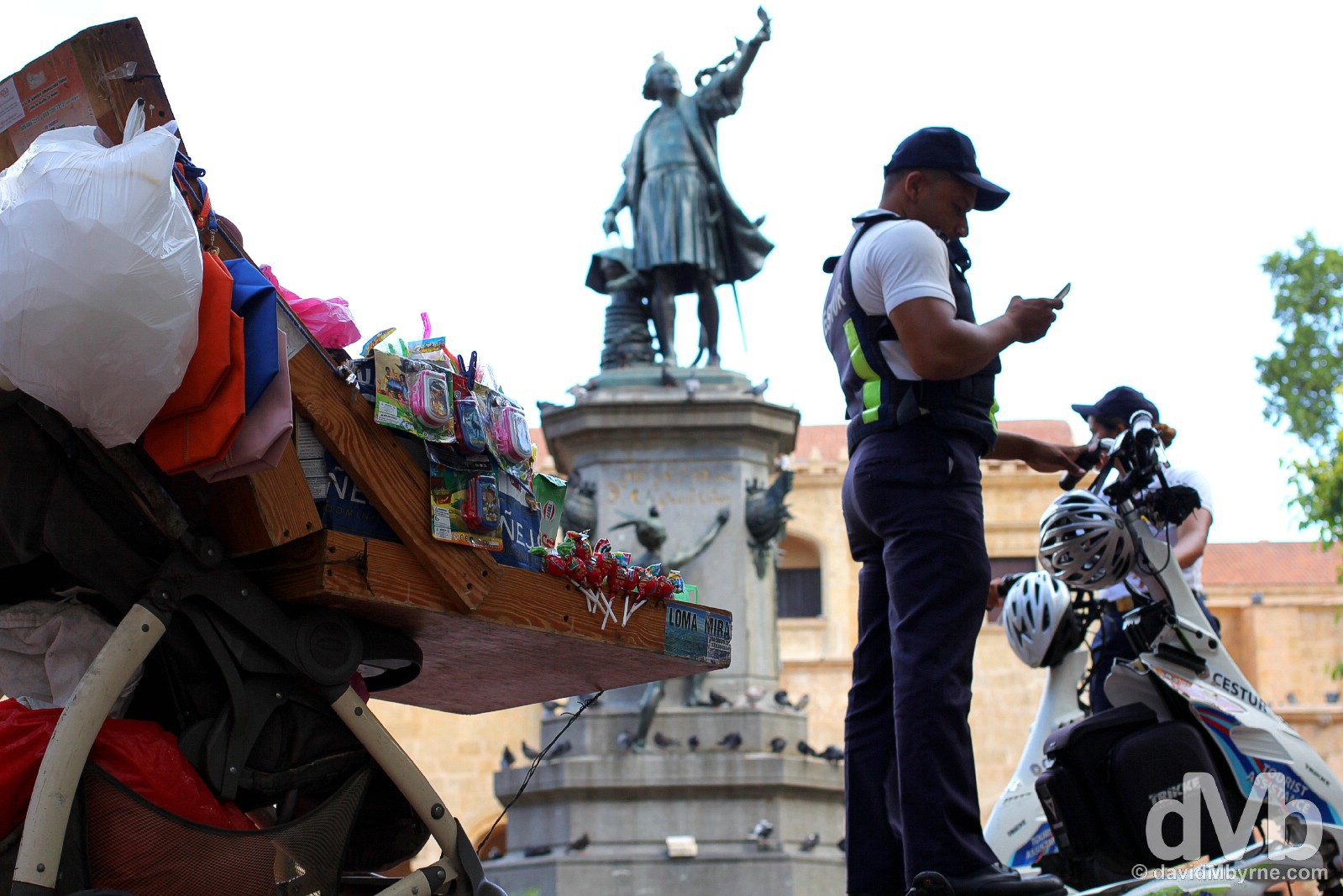
Pride of place in Parque Colon is a statue of Christopher Columbus, one the legions of pigeons who frequent the square use as a perch. This is tourist central in Santo Domingo and thus hawkers/vendors, touts, taxi drivers, beggars & Tourist Police zipping round on Segway are all part of the scene most hours of the day. Parque Colon in Zona Colonial, Santo Domingo, Dominican Republic. May 26, 2015.
El Conde
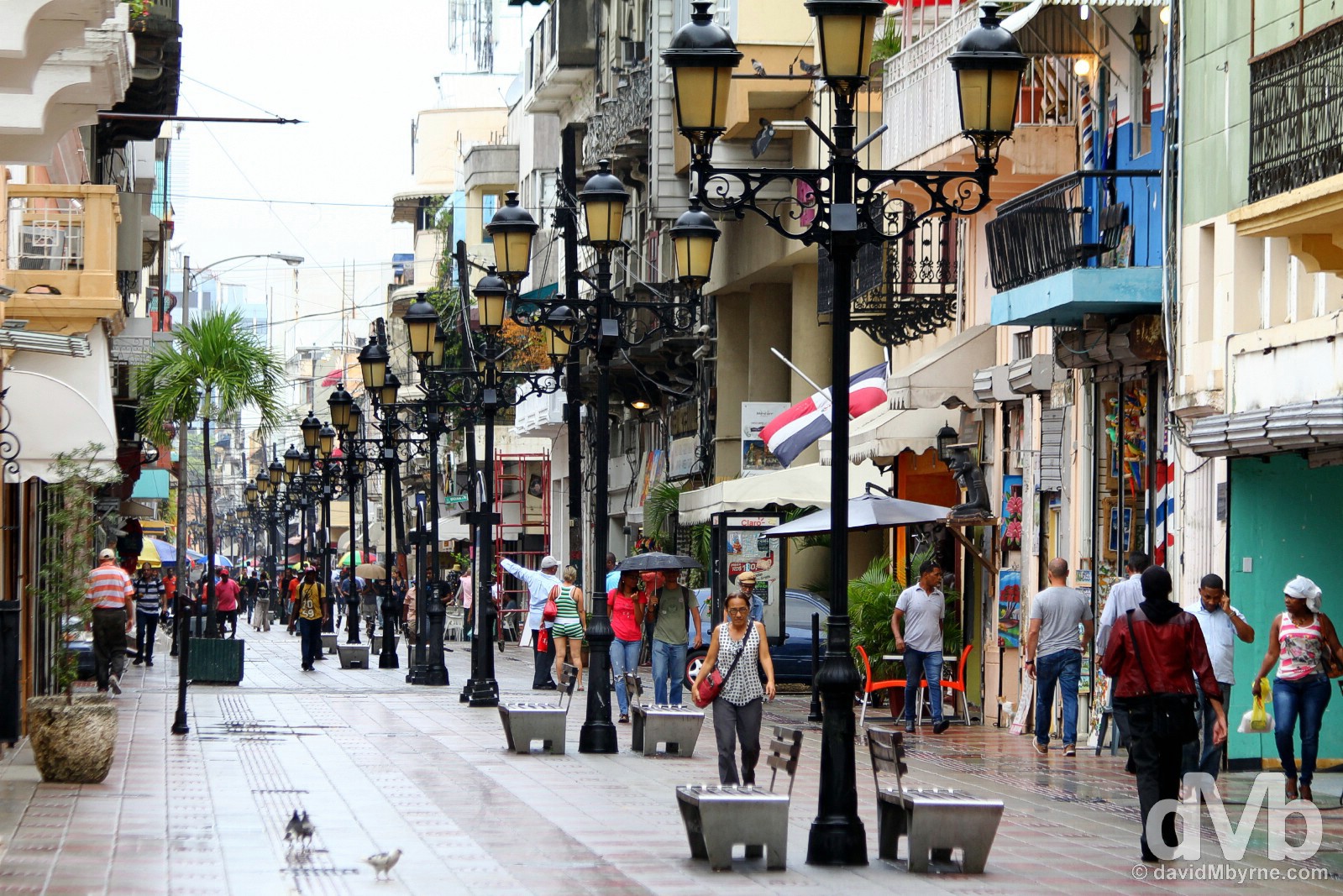
El Conde is the city’s main pedestrian strip, a modern commercial street lined with shops, restaurants, cafes and barbers. Yes, this is where I had my barber shop expereince. Pedestrianised El Conde in Santo Domingo, Dominican Republic. May 25, 2015.
Faro a Colon
On one of my ventures out of the Zona Colonial I visited the monstrous Faro a Colon (Columbus Lighthouse), a hulking 10-storey mass of concrete which looks more suited to somewhere in deepest, darkest Siberian Russia than in the hot & steamy Caribbean.
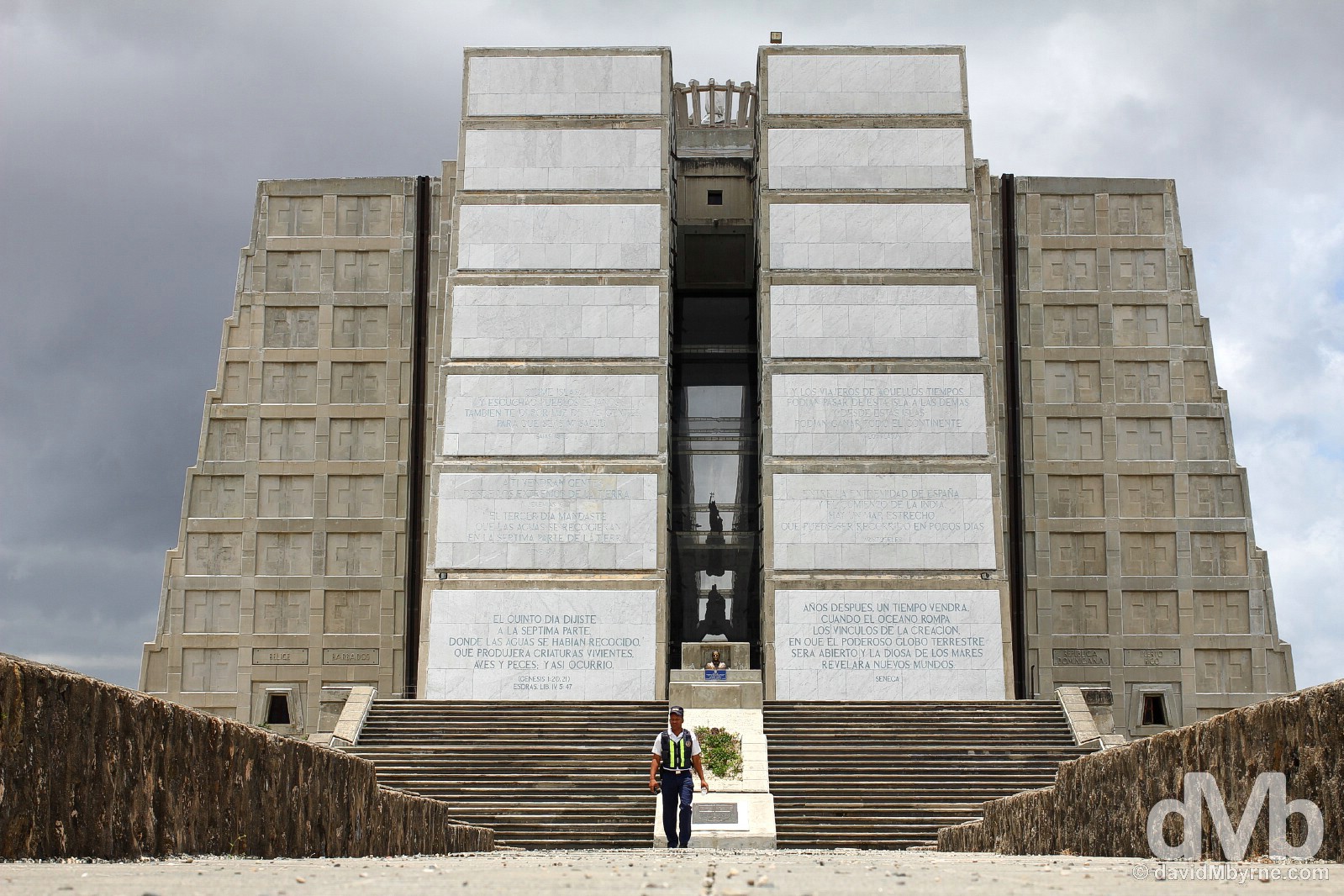
The mammoth Faro a Colon was built to commemorate Columbus’ landing in the New World. It had been on the cards since the 1920s – an international design competition for the structure was first launched in 1923 – but construction didn’t commence until the 1980s. More than 50,000 shantytown dwellers were displaced to make way for the US$100 million building which was officially opened in 1992 in the presence of Pope John Paul II and the King & Queen of Spain, contemporary representatives of the dual powers who sent Columbus on his way to discover the New World 500 years earlier in 1492. Built in the shape of a cross, it looks nothing like a lighthouse, although it does function as one (kind of) – lights on its roof can project, it is claimed, a light visible some 320 kilometres across the Caribbean in Puerto Rico (but the lights are rarely fired up as doing so drains the electricity grid for nearby neighbourhoods). Faro a Colon (Columbus Lighthouse) in Santo Domingo, Dominican Republic. May 26, 2015.
Christopher Columbus (1451-1506)
In 1483, when he was just 32 years old, Italian born Columbus approached the King of Portugal when searching for sponsors for an expedition – he wanted to search for Asia (“the Indies” for him), specifically the cities of China & Japan, for the purposes of effecting commercial trade. Rejected by Portugal, he turned to Spain, at the time the most powerful country in the world, and eventually, and after years of lobbying, convinced the Catholic monarchs of the country to fund his jaunts. (In 1498, Columbus sent his brother Bartolome to seek funding from King Henry VII of England, then a maritime minnow. He was rejected but years later the English did take to the seas, the result of which sowed the seeds for them colonising North America. How different history would have been had the English colonised Latin America instead of the Spanish, two nations that were to go on and fight many a war over their respective colonies with England wresting control of various Caribbean islands from the Spanish, islands today collectively known as the British West Indies & most of which had been discovered by Columbus). In 1492 Columbus set sail on the first of four expeditions he’d make, all in the service & for the benefit of Spain, making landfall in Hispaniola, the Caribbean island made up of present-day Haiti & Dominican Republic, discovering the New World in the process. The success of the first voyage was followed by a second in late 1493 on which he was accompanied by 1500 colonisers and which saw him sail with the titles Admiral of the Oceans, Viceroy & Governor of the Indies. On this trip he constructed the first European settlement in the Americas, La Isabella, on the north coast of present-day Haiti, & he explored Cuba & Jamaica, all the while searching for China. The failure of La Isabella as a settlement, and thus his administration of the island of Hispaniola, saw him return to Spain in 1496 to offer his explanations to the Spanish King & Queen. In 1498 he’d set off again & on this, his third mission, he’d discover Venezuela (but still no China). His final voyage commenced in 1502 & ended up being a 2-year, ill-fated search for a canal leading to the Island of Spices. And that was that. Columbus never did sail the Pacific but still believed, and right up until his death in Spain in 1506, that he had at the very least reached the extremities of Asia. Truth be told, he was nowhere near.
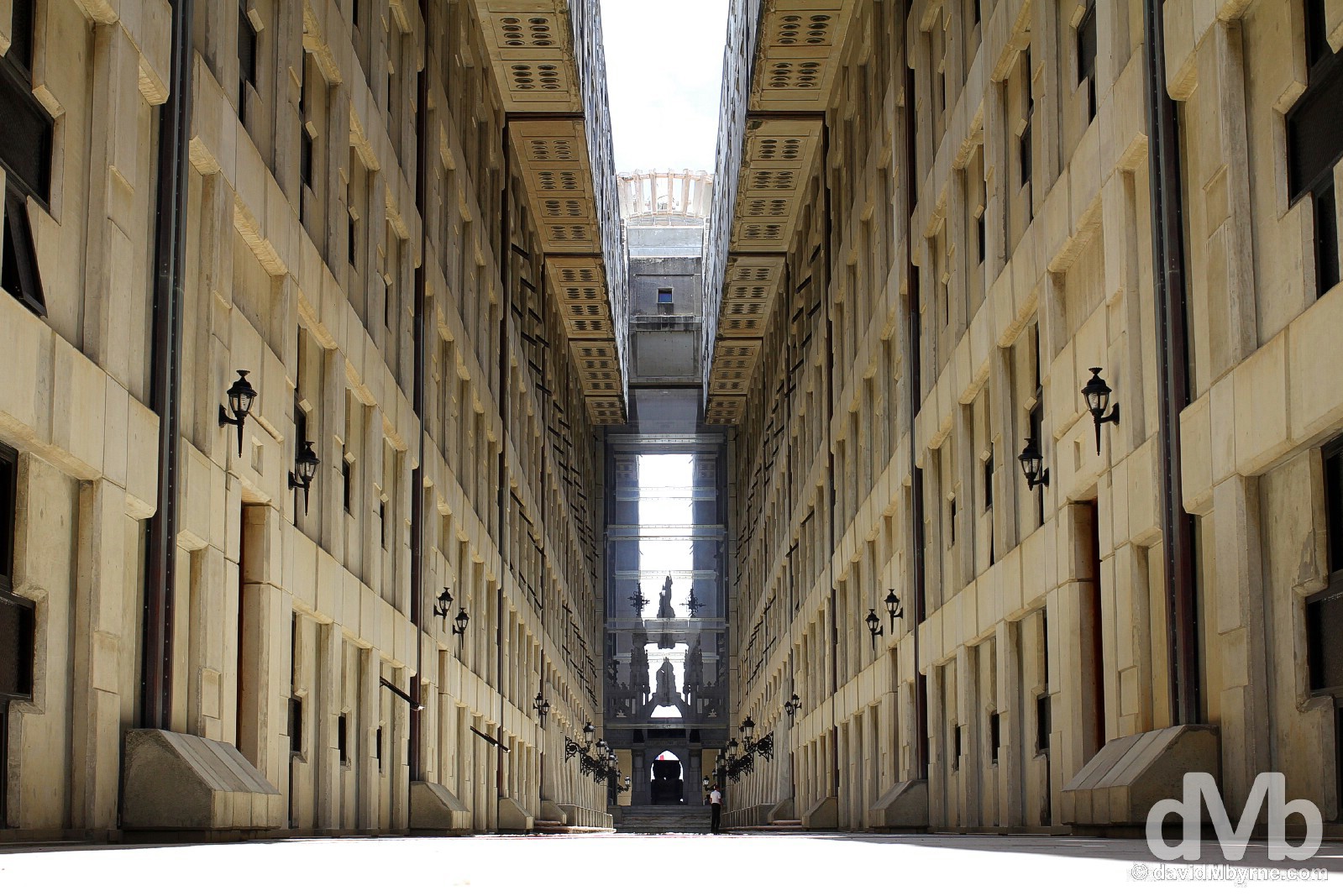
The exterior corridor in the interior of the Faro a Colon. Pride of place in here, seen in the distance at a point that is the intersection of the cross’ arms, is a white, marble-heavy tomb purportedly holding Columbus’ remains, something both Spain & Italy reject – they both say they have the seafarer’s remains. Rooms either side of this passageway house displays detailing Columbus’ journeys & presentations from other Latin American (and some Asian-Pacific) countries, presentations gifted to the Faro a Colon to mark its 1992 opening. Aside from that the rest of the structure doesn’t seem to serve any discernible purpose; as White Elephants go this one is quite impressive. Inside the bowels of Faro a Colon (Columbus Lighthouse) in Santo Domingo, Dominican Republic. May 26, 2015.
PUNTA CANA || BEACHES & ALL-INCLUSIVE RESORTS
Date || May 29, 2015
Location || Bavaro, Punta Cana ( )
)
The backbone of the lucrative Dominican Republic tourist industry, Punta Cana, at the extreme east of the country, is an iconic region of sun, sea, sand and the all-inclusive resort. This is where the vast majority of travellers who visit the DR come. Here & here only, safe in their plush, gated enclave fronting the aquamarine Caribbean. As holidays go you could do worse. A lot worse.
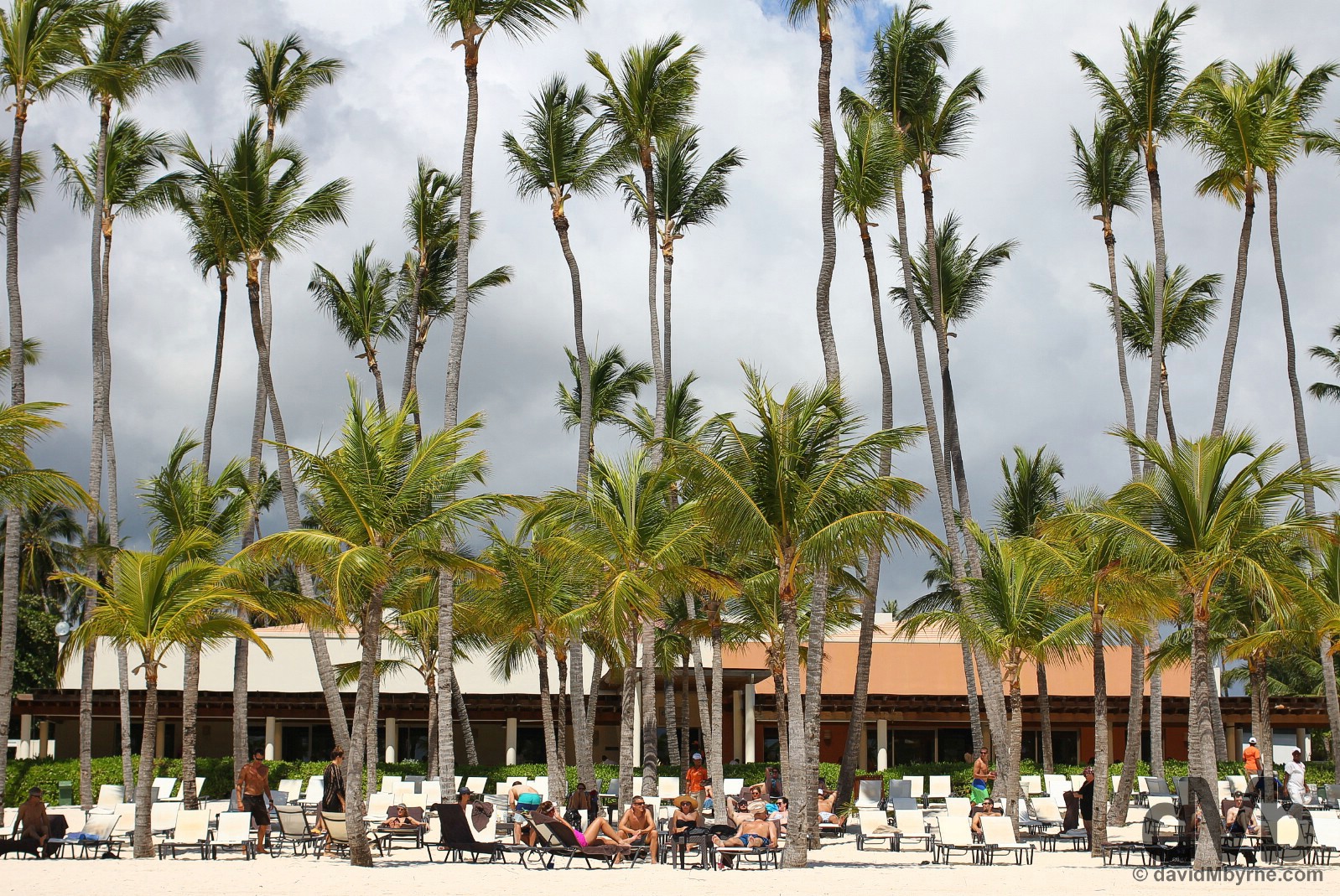
Cattle ranching, hardwood exports & sugar used to be the breadwinner of the Punta Cana region. Then in the 1960s a resort was built, ironically by converting an old sugar mill, and the rest is history. These days exclusive resorts, collectively offering over 30,000 rooms, line the coast, separated from the soft, white-sandy beaches only by an unbroken line of by freakishly tall, swaying coconut palms. Bavaro Beach, Punta Cana, Dominican Republic. May 28, 2015.
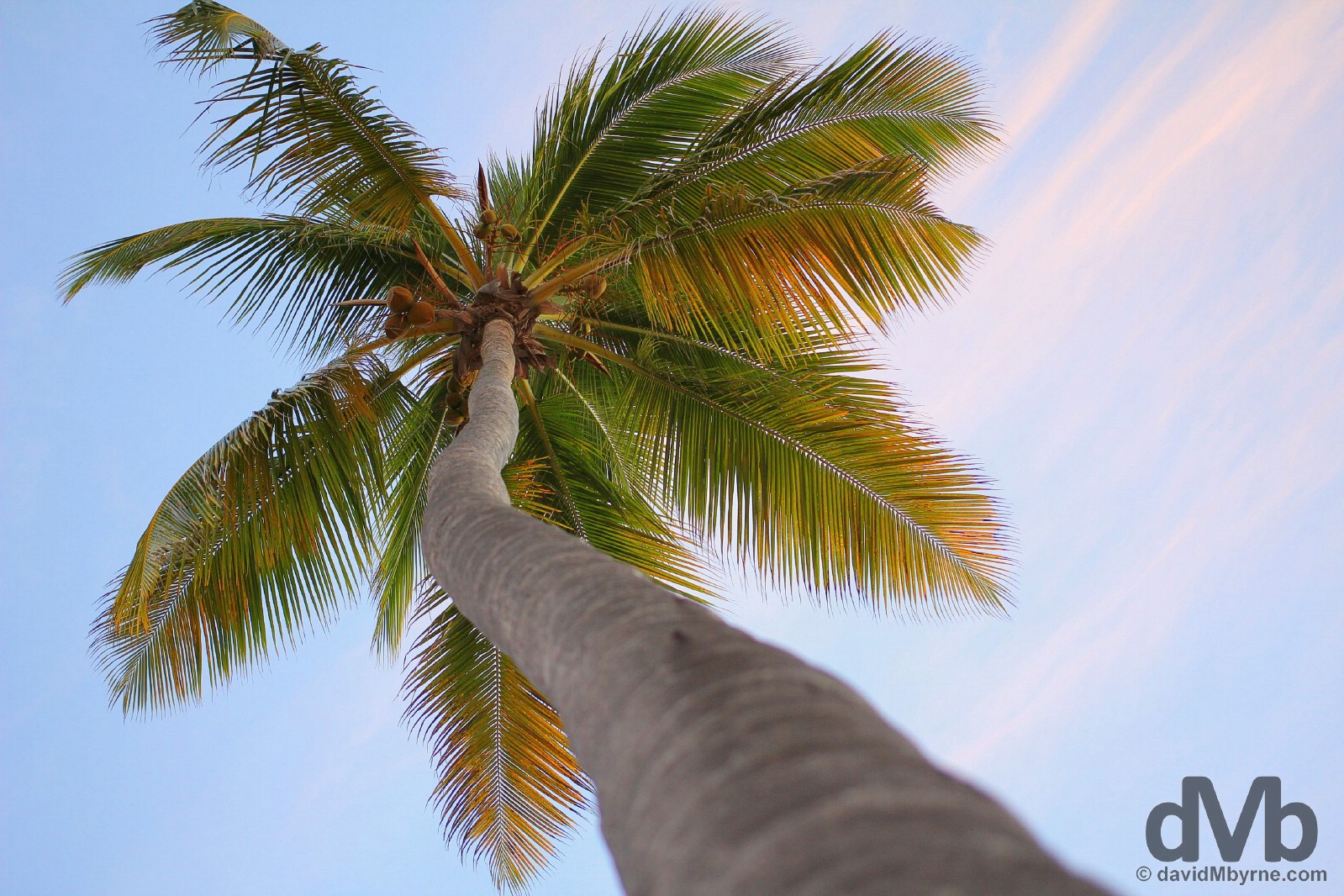
A coconut palm on Bavaro Beach, Punta Cana, Dominican Republic. May 28. 2015.
The all-inclusive, private, gated resort fronting an idyllic beach, where every whim is catered to for the duration of a stay, is a simple tried & tested formula and one that works very well here in Punta Cana. As resort locations go it’s rather nice, rather inviting and it’s not hard to see what attracts the thousands of beach-loungers who come here each year. While I’m not a big lounging on the beach kind of traveller (I get bored too easily/quickly), I did enjoy the two days I spent loving myself stupid on the regions busiest, most built-up stretch of soft, white sand, Bavaro Beach. Every now an then I’d leave the beach, popping in & out of the string of resorts, passing the ‘Guests Only’ sign in the process; in such a laid-back place it’s hard to feel like you’re breaking the rules.
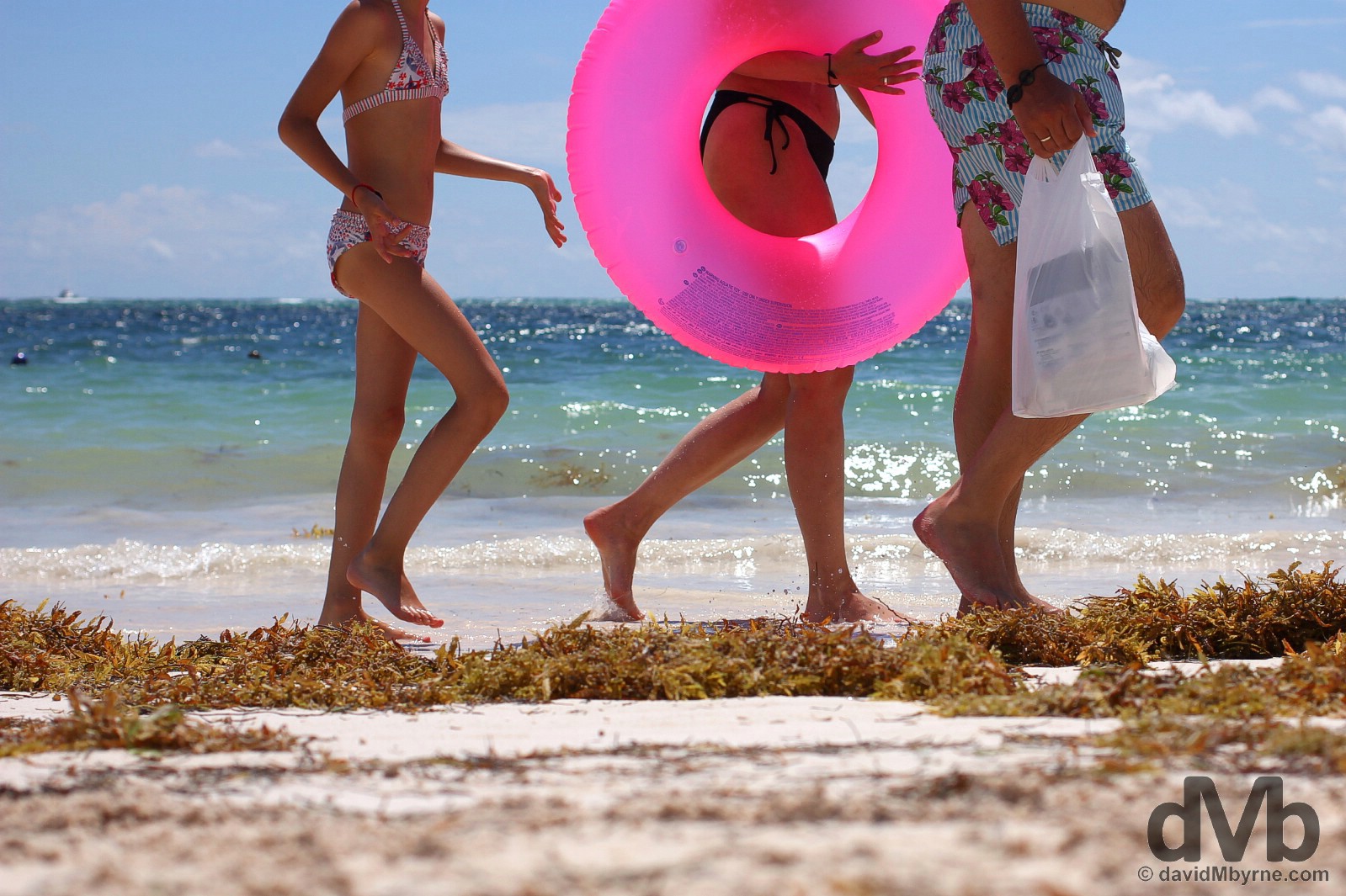
A family strolling on Bavaro Beach, Punta Cana, Dominican Republic. May 28, 2015.
There’s not a whole lot to photograph on a beach, even a really nice one like Bavaro (there’s not even a sunset here as Punta Cana faces east) but here’s some more of of what I captured over the last few days, my last few in the Dominican Republic (I’ve a flight in a few hours from Punta Cana’s International Airport to San Juan in Puerto Rico).
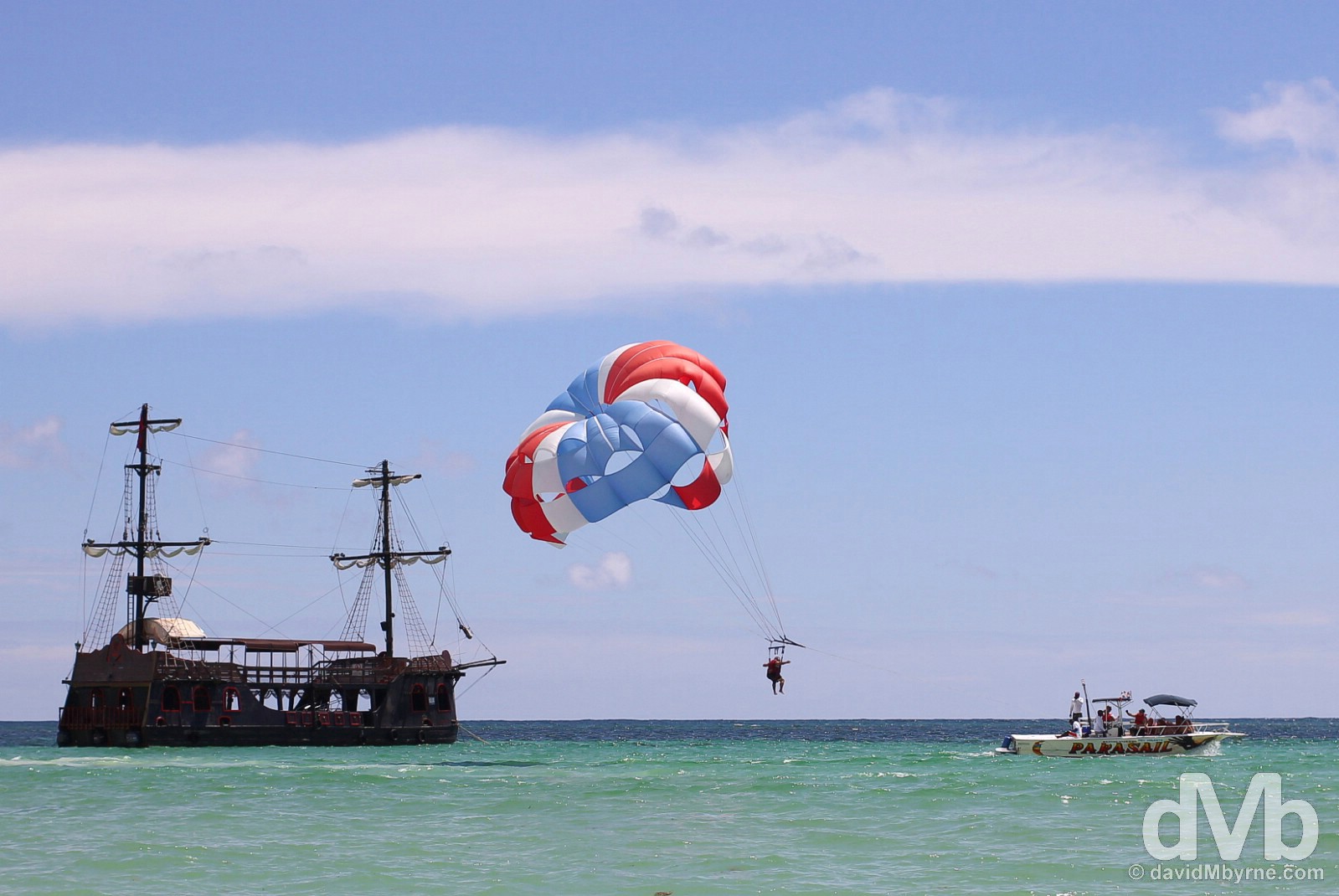
Offshore of Bavaro Beach, Punta Cana, Dominican Republic. May 28, 2015.
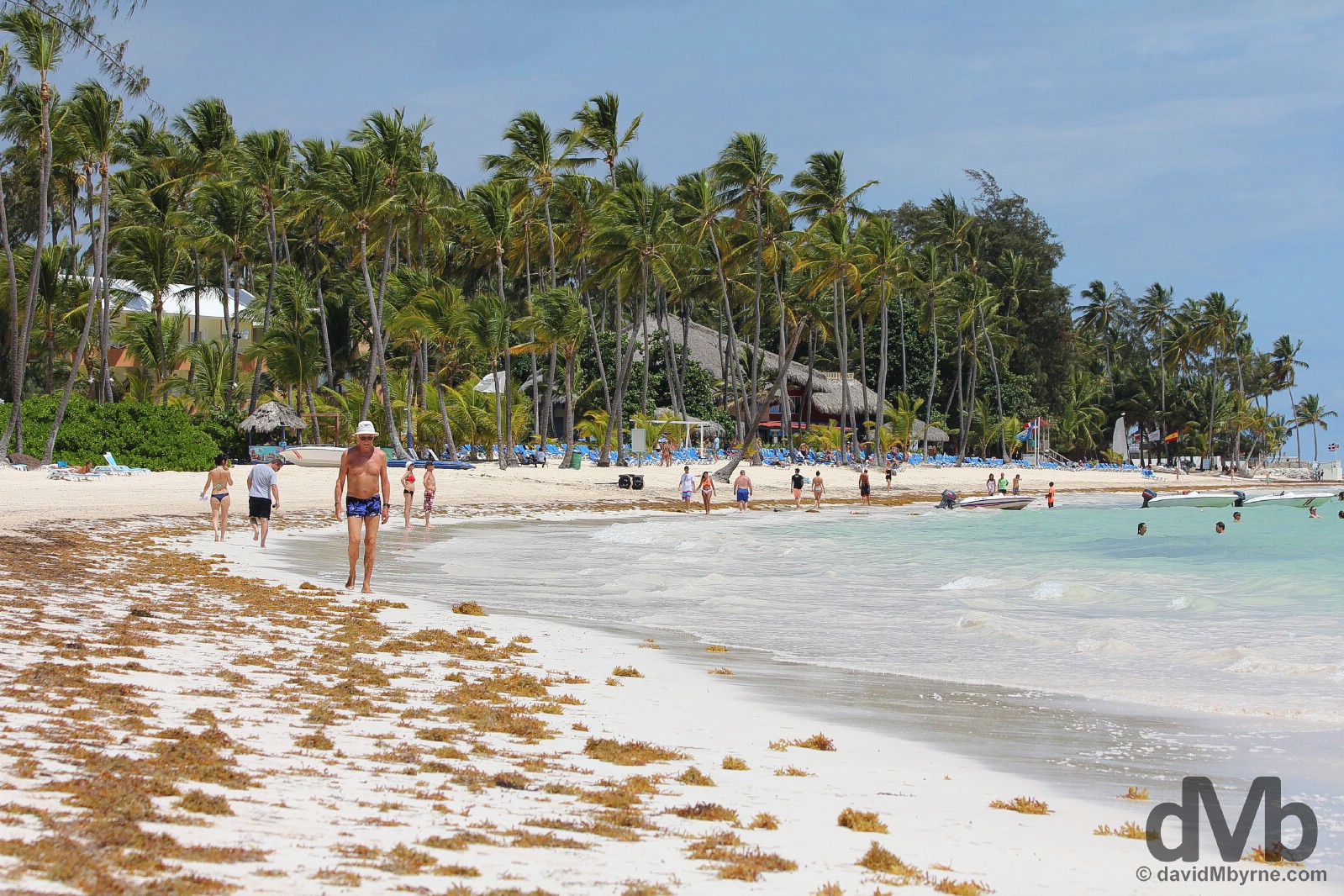
Playa El Cortecito, right next door to Bavaro Beach, Punta Cana, Dominican Republic. May 28. 2015.
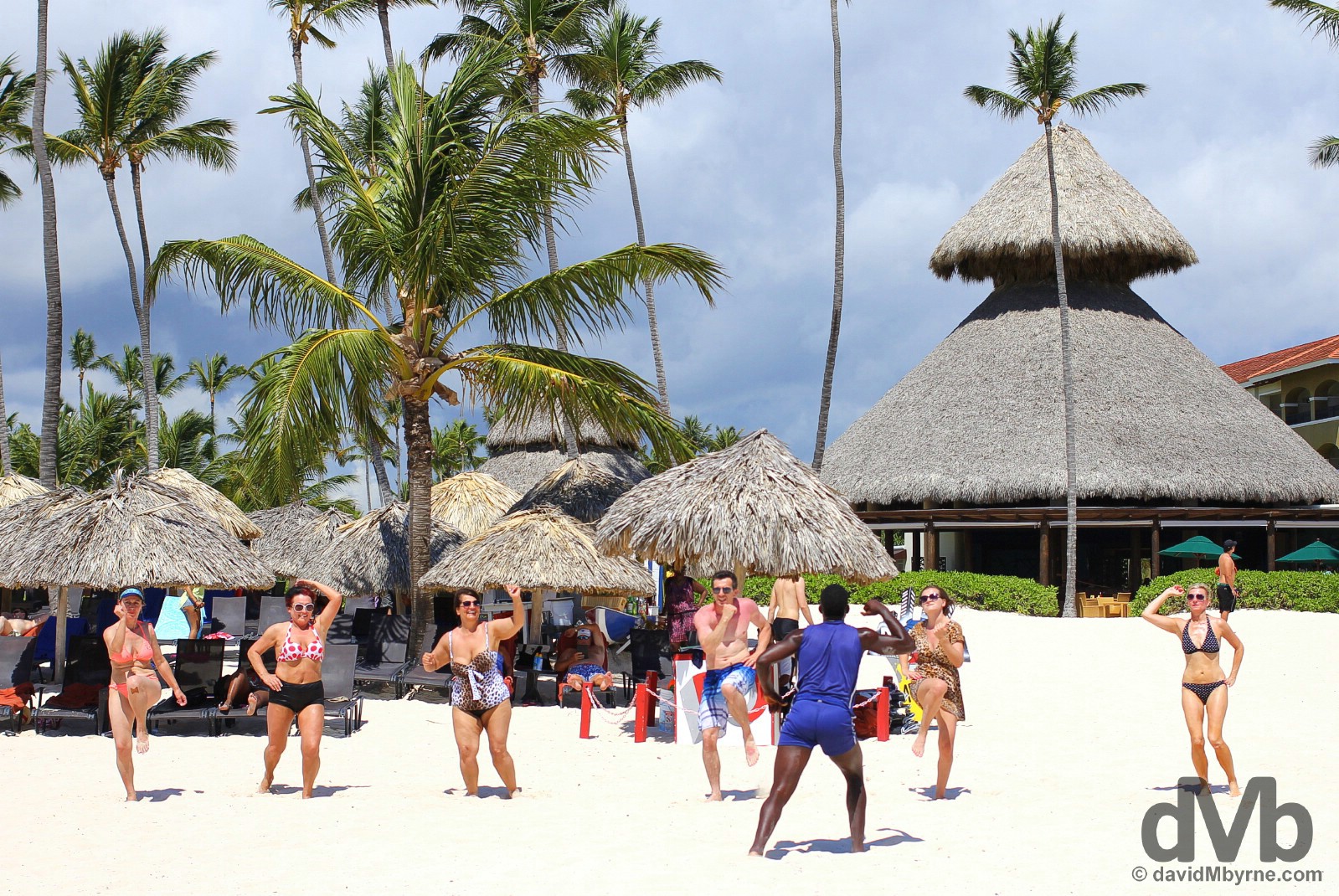
A not-so-laid-back early morning workout on Bavaro Beach, Punta Cana, Dominican Republic. May 28, 2015.
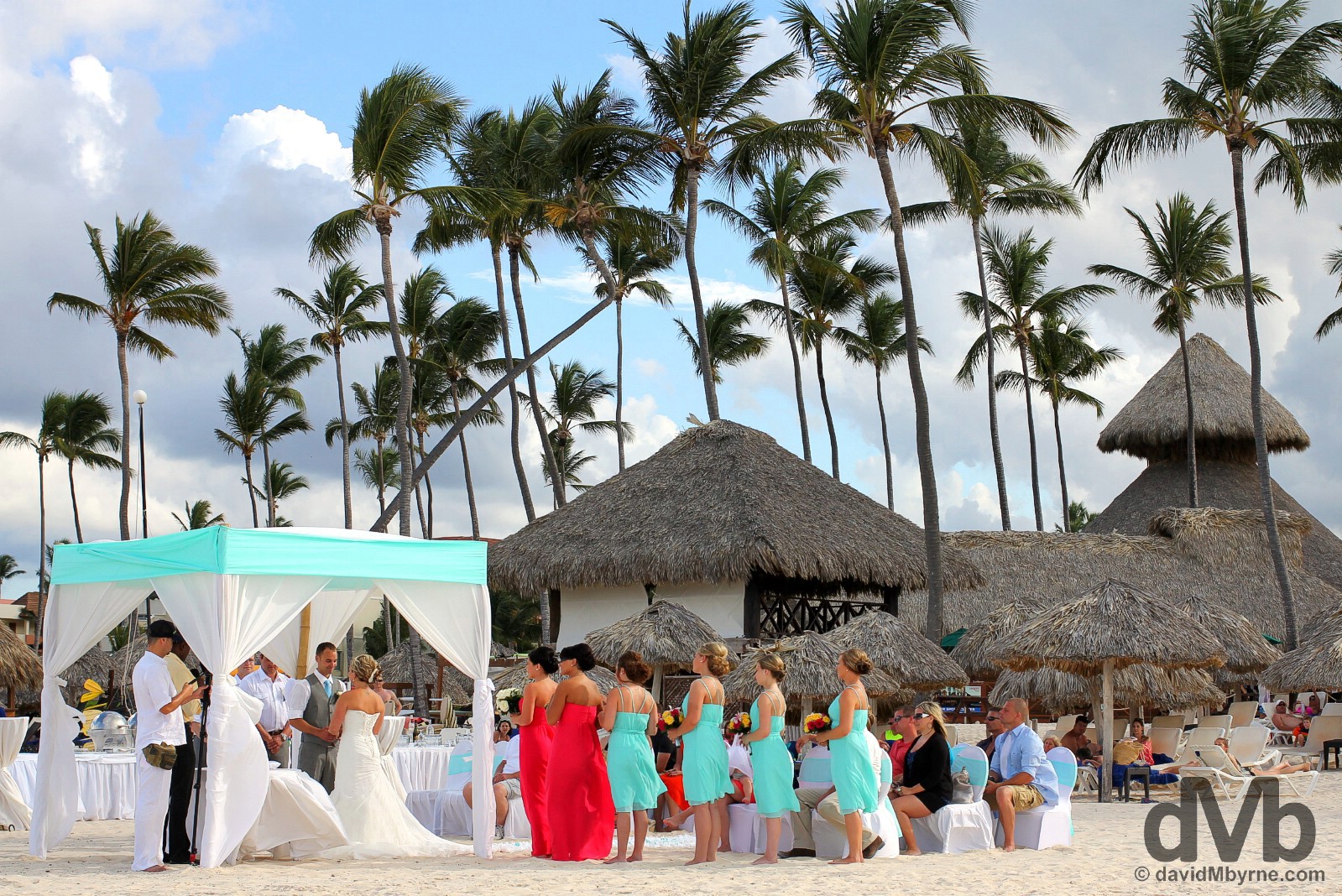
Seemingly the resorts on Bavaro Beach are popular places to tie the knot (& why not, wedding & honeymoon all-in-one); I passed at least 6 beach weddings during the 2 days I was here (all beaches in DR are public no matter the exclusiveness of the resort lording over it meaning they are open to all). Bavaro Beach, Punta Cana, Dominican Republic. May 27, 2015.
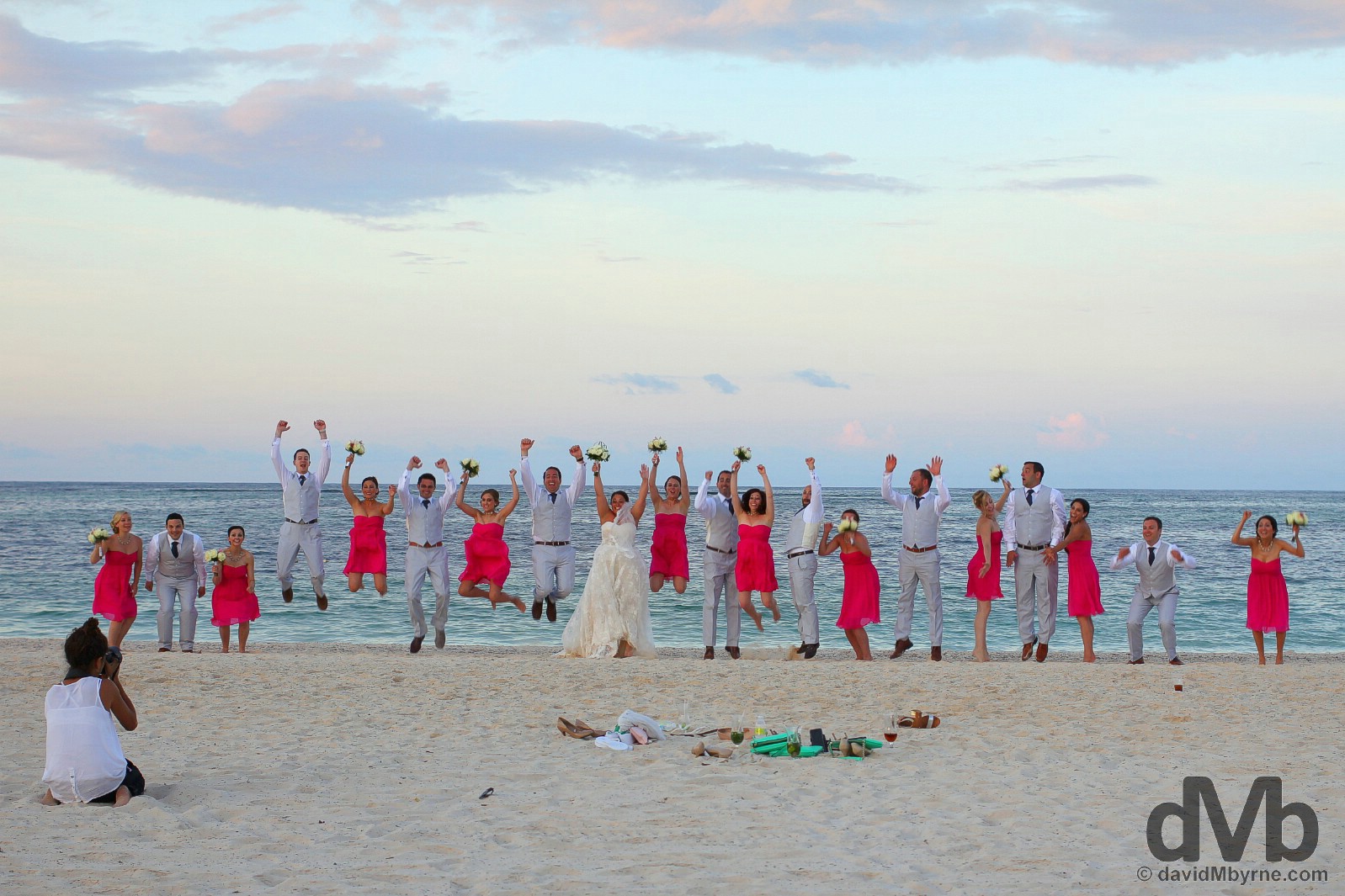
I mean, a ridiculously large wedding party, no doubt a view shared by the poor photographer when trying to get them to jump in unison, something she had immense difficulty accomplishing. Bavaro Beach, Punta Cana, Dominican Republic. May 28, 2015.
PUNTA CANA || THE MISSED FLIGHT & LATE DEPARTURE
Date || May 29, 2015
Location || Punta Cana International Airport
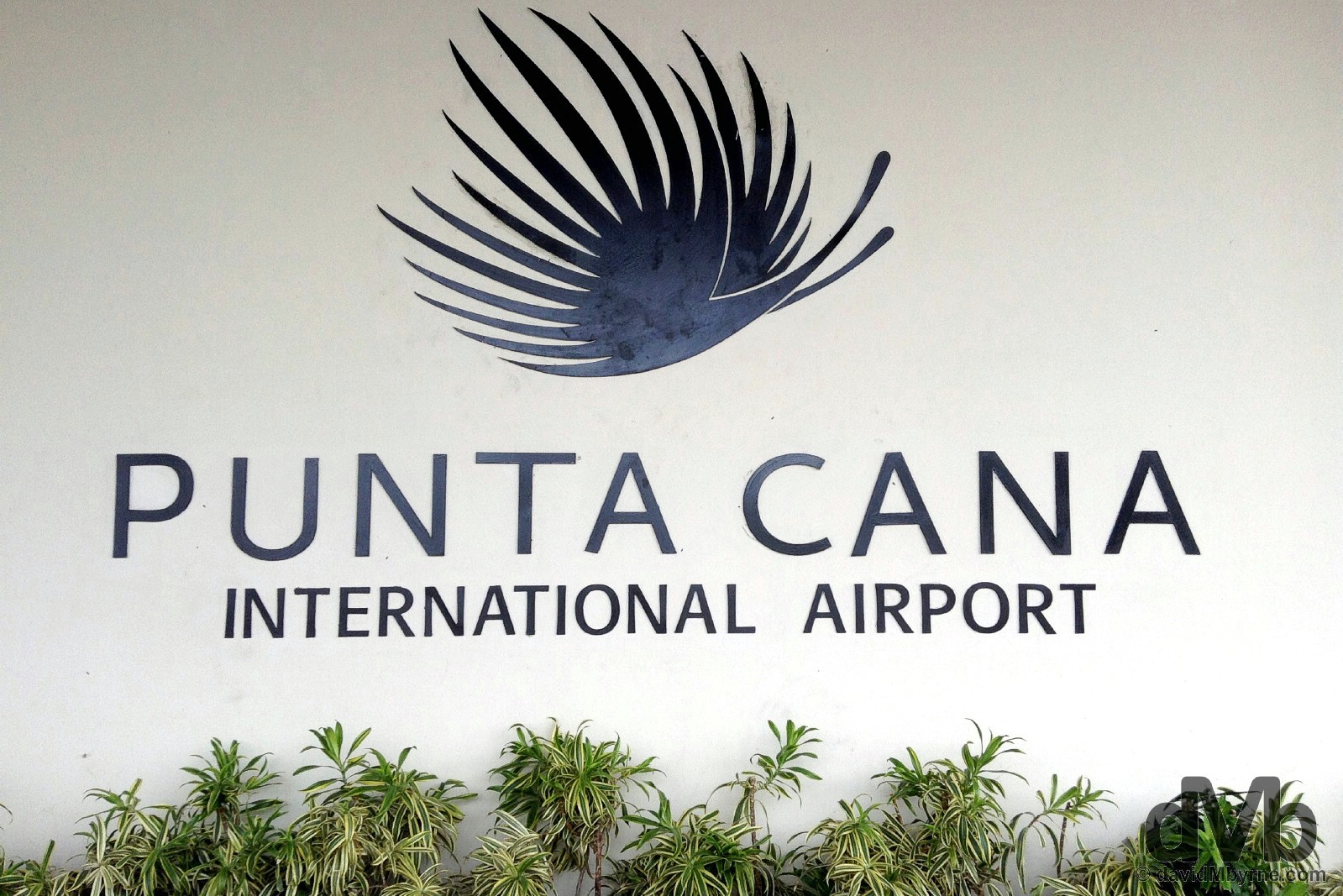
Punta Cana International Airport, Dominican Republic. May 29, 2015.
Well well well. A 30 kilometre ride on the back of a motorbike, 20 kilogram backpack and all, got me here to Punta Cana International Airport for my flight to San Juan, Puerto Rico. Shortly after arriving I got a shock when I realised my JetBlue booking was for yesterday, Thursday, not today, Friday. I did a double, triple take even but the booking still said Thursday, May 28. Missing a flight in Grand Cayman a few weeks ago was one thing (that was because of a late check-in) but missing a flight by a whole day. I don’t do that. Or at least I didn’t.
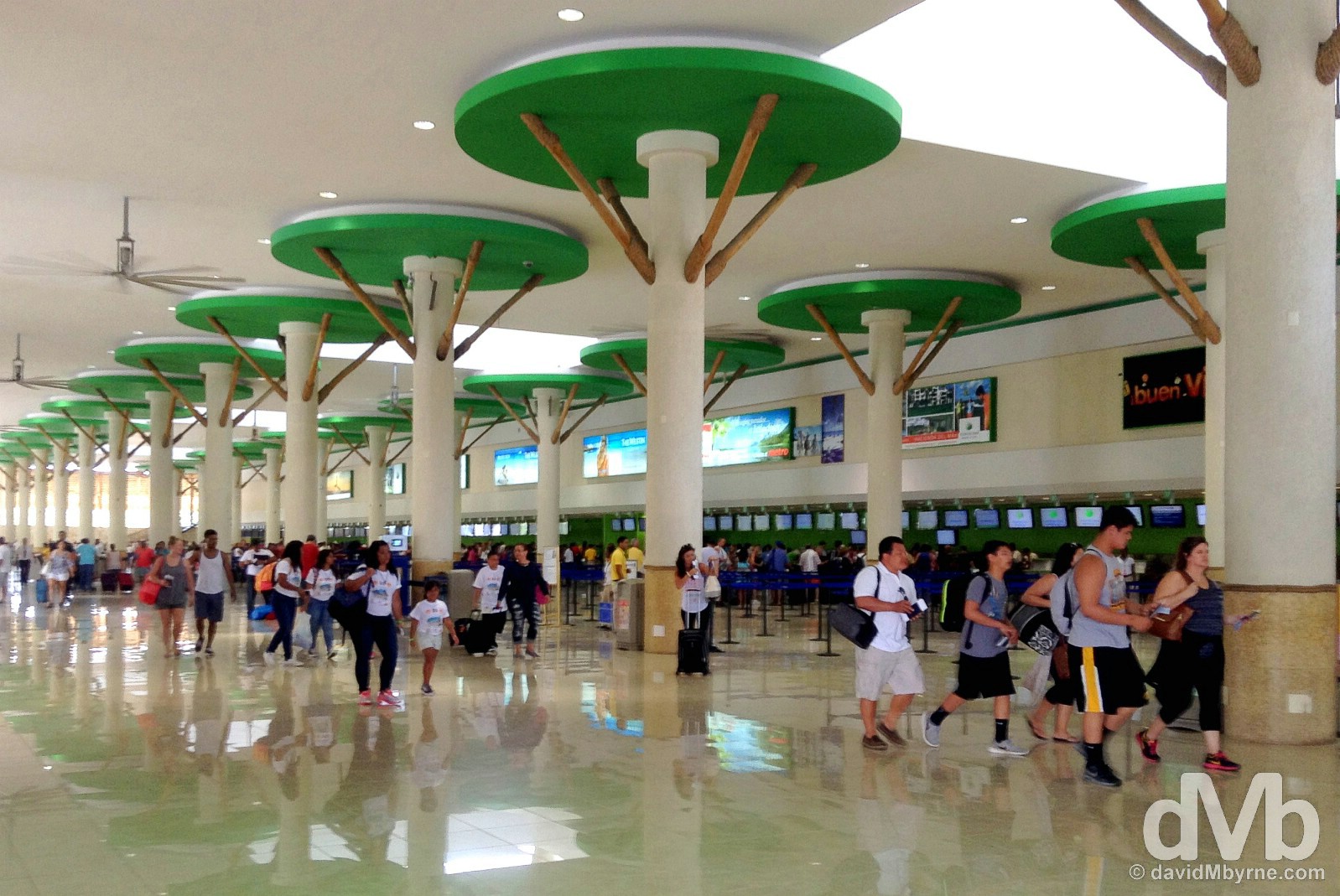
The gorgeous airy interior of Punta Cana’s International Airport did little to ease the realisation that I was a douche for missing a flight by a whole 24 hours. Punta Cana, Dominican Republic. May 29, 2015.
JetBlue To The Rescue
Using the free airport Wi-Fi I was quoted €600 for a later flight. Ouch. With no ticket counters in sight, I sauntered up to the JetBlue check-in counter, explained my totally avoidable reason for presenting here a day late, and asked after buying a ticket for today’s 15:33 flight to San Juan. Abraham, a JetBlue employee, quoted me $384 (or it might have been $386… it was definitely $380 something, this after previously tweeting how I was miffed at the initial $200 fare for such a brief one-way fight). ‘C’mon buddy’ I said, ‘it’s a 40-minute flight.’ Abraham said he’d see what he could do and after speaking with who I assumed to be his uber-friendly supervisor I was told I’d be on standby for the flight at no extra cost; ‘Things look good for you getting on’, I was told, followed by ‘we like to try and help people out’ (the airline’s official slogan is ‘You Above All’). They even brought me upstairs to complete U.S. (Puerto Rico is a self-governing U.S. commonwealth) e-visa formalities, my previous e-visa for the U.S. having not yet expired but I, whoops, forgot that I’d since changed my passport – I was informed that tending to this on my laptop via the free Wi-Fi wasn’t a good idea. So all in all I screwed up today (maybe I’m being just a bit too blasé, too laid-back with regard to the intricacies of travelling through a region as relaxed as the Caribbean) and I needed help. JetBlue’s affable & accommodating staff came to the rescue & for that I’m grateful. So thank you JetBlue Airways. I’m sorry for being a douche. You guys rock & I’ve already booked a flight to St-Maarten with you next week. Best not miss that one.
